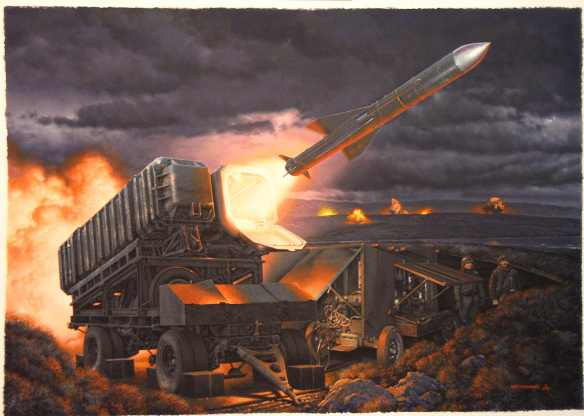Exocet – Land-based firing by MM38 battery at Hooker’s Point, near Stanley, that hit and damaged HMS Glamorgan 12th June. Stanley airfield in the background. DANIEL BECHENNEC
By this time the general intelligence assessment was that Argentina had accepted that the military defence of the Falklands was inevitable and that Great Britain must be dragged to the negotiating table by staging a high-profile incident, for instance targeting HMS Hermes or Invincible. But the Argentinian Navy had lost the maritime battle. Strengthening its military presence on West Falkland to threaten San Carlos and sandwich the British between Stanley and West Falkland with the airborne Strategic Reserve was another option. The Air Force had sufficient transport with its C-47s Dakotas, F-27 Fellowships and C-130 Hercules for a mass drop. The Navy could help with its three L-188 Electras, as could the Army with its three G-222 transports. But the Air Force could not guarantee a lengthy period of air superiority unless the two British aircraft carriers were neutralized, either by the weather or attack.
Soon after the start of British attacks on 1 May the Argentine Navy evaluated the possibility of installing an Exocet surface-to-surface system at Stanley to deter the Royal Navy from bombarding military positions. Transporting a shipboard system would take at least forty-four days and when a simple system needed to be devised, an engineering officer, Commander Julio Perez, and two civilians were tasked to come up with a solution, which they did within ten days. Christened the ‘Do-It-Yourself Firing Installation’, Perez’s development consisted of a generator, supporting hardware and two ramps for the Exocet box launchers all mounted on two trailers. The launchers themselves were cannibalized from two of Argentina’s A-69 corvettes. Perez’s team designed a firing sequence from a box with four telephone switchboard switches; these were manual to save time. Each had to be thrown in specific order timed by a stopwatch. This land-based system was ready in mid-May, but an attempt to fly it and Perez to Stanley on 24 May was thwarted by British air activity. Eventually, in early June, the system was landed, but by this time very wet weather had set in and since there was a danger of the Firing Installation trailer becoming bogged down in the mud, a short stretch of the tarmac road between the town and airport was selected as the firing point. Each night at 6pm the system was dragged from beneath camouflage netting and placed behind a 16-foot high bunker. It had to be ready by 8.30pm when British ships tended to begin their bombardments. The Air Force Westinghouse radars with the 2nd Air Surveillance and Control Group swept a 60-degree arc to the south of Stanley Common for long-range search. The Army provided fire control with its AN-TPS 43 Early Warning radar. Three Exocet missiles were sent. The first one proved to be defective, the second was wasted when a connection to the transformer was incorrectly fitted and veered to the right, as opposed to the left. The third was more successful.
On the night of 27/28 May a large projectile hurtled across the flight deck of HMS Avenger while she was on the gun line south of Port Harriet and out of range of conventional artillery. It was then correctly assessed that Argentina might well have installed an Exocet system on the Falklands and to minimize the risk, Rear-Admiral Woodward created a 25-mile sanitized circumference from the suspected launch pad that no ship was to enter. It is significant that Exocet is a sea-skimming missile and therefore it is suggested that the Argentinians would have some difficulty hitting anything to the west because of the landmass. The problem for the Royal Navy was that Exocet was a weapon widely used by NATO and consequently a counter-measure had not been developed. The sinking of HMS Sheffield and the Atlantic Conveyor led to some Royal Navy commanders becoming pre-occupied with it almost to the exclusion of risk-taking.
Four more missiles arrived by C-130 during the night of 5 June, but it was not until about 2.35am on the night of 12 June that a target presented itself. At 2.15am HMS Avenger and the County-class destroyer HMS Glamorgan had both completed the night’s mission of providing naval gunfire support to 3rd Commando Brigade attacking Mount Longdon, Two Sisters and Mount Harriet and left to return to the Carrier Battle Group. Unfortunately for her Commanding Officer of HMS Glamorgan, Captain Michael Barrow, his destroyer clipped the sanitized area and when her radar footprint was detected by the Exocet launch team, a missile launched. Originally mistaking it for a 155mm shell, HMS Avenger recognized the radar configuration to be an Exocet and the target to be HMS Glamorgan. Barrow held his fire and then, when the missile was within a mile and half, he opened up with a Seacat but missed. However, the incoming missile was deflected sufficiently upward to miss the hull of the destroyer, but it slithered across the pitching deck into the hangar and exploded. Burning fuel from a wrecked Wessex helicopter spilled down a hole in the deck into the galley area, causing a major fire, and a fireball ripped into the gas turbine gear room. An officer, six air maintenance crew, four chefs, a steward and a marine engineer, totalling thirteen men, were killed and fourteen injured. Very many of those ashore witnessed the glow of the missile and the tiny explosion on the horizon as the Exocet exploded. Although HMS Glamorgan had an 8-degree list from the weight of water needed to fight the fires, she maintained a steady 18 knots and remained fully operational in spite of the damage.
